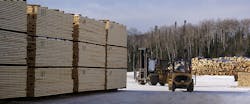Will lumber tariffs offer U.S. truckers new opportunities?
Situated near the Superior National Forest and George Washington State Forest in Gilbert, MN, Scott Dane has plenty to smile about this week.
The executive director of the Associated Contract Loggers and Truckers of Minnesota told Fleet Owner the U.S. decision to slap a 20% import tariff on Canadian softwood lumber will greatly benefit his 200 members, which includes 40 trucking companies.
“If this tariff means a reduction in imported wood and more production of wood in the state of Minnesota and the Midwest, then that will certainly increase the market for our loggers and truckers,” Dane said.
Earlier this week, the Trump administration formally announced tariffs averaging about 20% on Canadian exporters of softwood lumber.
Commerce Secretary Wilbur Ross said at a media briefing about $15 billion of softwood lumber is used in U.S. houses, and about 31.5% comes from Canada, translating into about $1 billion from the tariffs annually.
The tariffs are the latest chapter in a long running dispute. In 2005, the nation’s signed the U.S.-Canada Softwood Lumber Agreement, which set import limits. However, tensions were on the rise since that deal expired.
While Canada vowed to fight the tariffs, Sen. Ron Wyden, an Oregon Democrat who has vocally opposed Trump at almost every turn, praised the administration’s decision. Oregon is among the states that have sought tougher measures by the federal government on Canadian lumber.
Conversely, the U.S. National Association of Home Builders said the tariffs will boost housing prices by at least $1,000, and jeopardize thousands of jobs in the home construction industry.
It said 33% of the lumber used in the U.S. in 2016 was imported, and over 95% of that supply came from Canada.
For Dane, who noted most of his members use their own trucks to haul products, the tariffs are about fairness. He took issue with the homebuilders’ report, saying “they want to go to Wal-Mart for every two by four at the expense of the domestic forest industry.”
While a large percentage of Canadian wood enters the U.S., he asked, “how much of ours is going into Canada?”
“Zero,” he said in response to his own question.
Dane is hoping the tariffs will extend beyond just softwood to include finished forest products and other categories.
Like Dane, Henry Schienebeck, executive director of the WI-based Great Lakes Timber Professional Association, said he was pleased with the tariffs.
However, the former truck driver tempered the expectations, saying the damage from the recession and cutbacks in freight rail service in his area limits the upside.
Like manufacturing, the U.S. lumber industry has been shrinking for many years. The U.S. Lumber Coalition estimated 360,000 still work in sawmills or jobs linked to timber, including truckers.
With the tariffs projected to hit British Columbia companies particularly hard, Susan Yurkovich, president of the B.C. Lumber Trade Council, said in a statement "Canadian lumber imports don't pose a threat to the U.S. lumber industry. There is enough North American demand to grow the U.S. industry while also allowing Canada to supply its U.S. customers, as we have been doing for decades."
In 2014, forest exports from British Columbia were $12.4 billion, with about half coming from softwood lumber.
Louise Yako, president and CEO of the British Columbia Trucking Association, told Fleet Owner the tariffs would likely be discussed at the group’s upcoming board meeting, but there had not been an immediate outcry from members.
She noted earlier media reports warned the tariffs could be higher than what was ultimately announced.
Back in the U.S., Jonathan Paine, president and CEO of the National Lumber and Building Material Dealers Association, expressed a desire of many.
"Both sides should work cooperatively toward a resolution that ends the trade dispute and provides predictability and stability to the housing industry,” he said.
About the Author
Neil Abt
Neil Abt is a former FleetOwner editor who wrote for the publication from 2017 to 2020. He was editorial director from 2018 to 2020.


